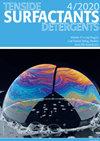阴离子型co2可切换尾部表面活性剂的表面和发泡性能
IF 1.2
4区 工程技术
Q4 CHEMISTRY, APPLIED
引用次数: 1
摘要
摘要CO2可转换材料,特别是CO2可转换表面活性剂,在环境研究中引起了极大的兴趣。通过提高可重复使用性和循环性,从而用可切换的表面活性剂取代常见的不可切换表面活性剂,从而降低材料成本和能源消耗,从而使工艺更加环保,这是一个巨大的潜力。受此启发,本工作研究了新型阴离子CO2可切换尾表面活性剂4-(甲基(辛基)氨基)丁烷-1-磺酸钠水溶液的表面和发泡性能。在N2存在下,未质子化的表面活性剂能够稳定泡沫。通过转换,即通过质子化表面活性剂烃链中的CO2响应性三烷基胺基团,表面活性剂的两亲性降低,这通过平台表面张力的增加和与非质子化的表面活性剂相比更高的CMC来指示。此外,质子化表面活性剂稳定泡沫的能力降低。本文章由计算机程序翻译,如有差异,请以英文原文为准。
Surface and foaming properties of an anionic CO2-switchable tail surfactant
Abstract CO2-switchable materials in general and CO2-switchable surfactants in particular are of great interest in environmental research. There is a great potential to make processes more environmentally friendly by enhancing reusability and circularity and thus reducing material costs and energy consumption by replacing common non-switchable surfactants with their switchable counterparts. Inspired by this, the present work deals with the surface and foaming properties of aqueous solutions of the novel anionic CO2-switchable tail surfactant sodium 4-(methyl(octyl)amino)butane-1-sulfonate. In the presence of N2, the unprotonated surfactant is able to stabilize foams. By switching, i.e. by protonating the CO2-responsive trialkyl amine group in the surfactants hydrocarbon chain, the amphiphilic nature of the surfactant is reduced which is indicated by an increase of the plateau surface tension and a higher CMC compared to the non-protonated surfactant. Furthermore, the ability of the protonated surfactant to stabilize foams is reduced.
求助全文
通过发布文献求助,成功后即可免费获取论文全文。
去求助
来源期刊

Tenside Surfactants Detergents
工程技术-工程:化工
CiteScore
1.90
自引率
10.00%
发文量
57
审稿时长
3.8 months
期刊介绍:
Tenside Surfactants Detergents offers the most recent results of research and development in all fields of surfactant chemistry, such as: synthesis, analysis, physicochemical properties, new types of surfactants, progress in production processes, application-related problems and environmental behavior. Since 1964 Tenside Surfactants Detergents offers strictly peer-reviewed, high-quality articles by renowned specialists around the world.
 求助内容:
求助内容: 应助结果提醒方式:
应助结果提醒方式:


